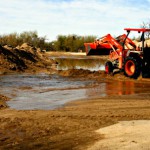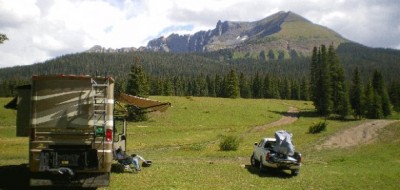
By Bob Difley
“When you are naked, it’s amazing how little courage you have,” writes Tom Stienstra in the San Francisco Chronicle relating to his recent camping trip into the mountains of California.
Remembering in the middle of the night that he had left his on-the-road dinner leftovers on the passenger seat in the truck when he set up camp in a remote section of a national forest, he rose about 2:00 AM to remove the leftovers before a bear discovered them and decided to break in for the goodies.
With only a penlight to approached his truck and came face to face with a 250-pound black bear. Before he had time to decide on the correct defence, the bear, appearing more shocked than he was, scampered off crashing through the bushes and brush to disappear in the woods, leaving behind a trail of urine (conceivably more frightened than Stienstra who did not).
The lesson to be learned for campers (that includes RVers) is not only the obvious one of not leaving food out – on the picnic table, littering the campsite, or on the pasenger seat of your truck – but also that the reaction of the bear – frightened and running away – is the natural and normal reaction expected from wild animals.
But that expectation has changed, and for the worst. Except for bears that live in the deeper reaches of forests and mostly out of contact with civilization, most have lost their fear of humans because of the unfortunate way humans view their responsibilities toward wildlife, especially bears, the results off which often end with injury and property damage to humans and death to the bears that have to be euthanized.
The bears of Lake Tahoe, Stienstra points out, have completely lost their fear of humans because of careless handling of food scraps and food wrappers (which carry the scent of food and attract bears as much as the food itself) by tourists, overflowing trash cans, and by local residents feeding them (one case he relates is a woman who places feeding bowls for bears in her back yard – eight bears were seen at one time feeding – and was attacked in August and put in the hospital).
To keep yourself and your campsite intact, ALWAYS contain and dispose properly of all food scraps in designated bear proof containers. A cooler is not bear proof as innumerable acouonts show bears breaking into vehicles to ravage coolers (and the vehicle broken into).
You can learn more about how to safely act and react in bear country and when encountering bears at the Bear Smart website.
Read Tom Stienstra’s entire article, “The problem with bears is the humans.”
For more RVing articles and tips take a look at my Healthy RV Lifestyle website, where you will also find my ebooks: BOONDOCKING: Finding the Perfect Campsite on America’s Public Lands (PDF or Kindle), 111 Ways to Get the Biggest Bang for your RV Lifestyle Buck (PDF or Kindle), and Snowbird Guide to Boondocking in the Southwestern Deserts (PDF or Kindle), and my newest, The RV Lifestyle: Reflections of Life on the Road (PDF or Kindle reader version). NOTE: Use the Kindle version to read on iPad and iPhone or any device that has the free Kindle reader app.



